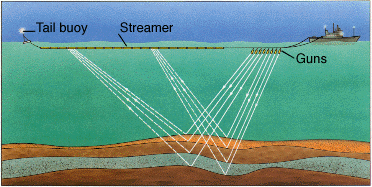1. n. [Geophysics]
The generation and recording of seismic data. Acquisition involves many different receiver configurations, including laying geophones or seismometers on the surface of the Earth or seafloor, towing hydrophones behind a marine seismic vessel, suspending hydrophones vertically in the sea or placing geophones in a wellbore (as in a vertical seismic profile) to record the seismic signal. A source, such as a vibrator unit, dynamite shot, or an air gun, generates acoustic or elastic vibrations that travel into the Earth, pass through strata with different seismic responses and filtering effects, and return to the surface to be recorded as seismic data. Optimal acquisition varies according to local conditions and involves employing the appropriate source (both type and intensity), optimal configuration of receivers, and orientation of receiver lines with respect to geological features. This ensures that the highest signal-to-noise ratio can be recorded, resolution is appropriate, and extraneous effects such as air waves, ground roll, multiples and diffractions can be minimized or distinguished, and removed through processing.
Synonyms: acquisition
See related terms: common midpoint method, explosive seismic data, gather, geophone, hydrophone, shotpoint
